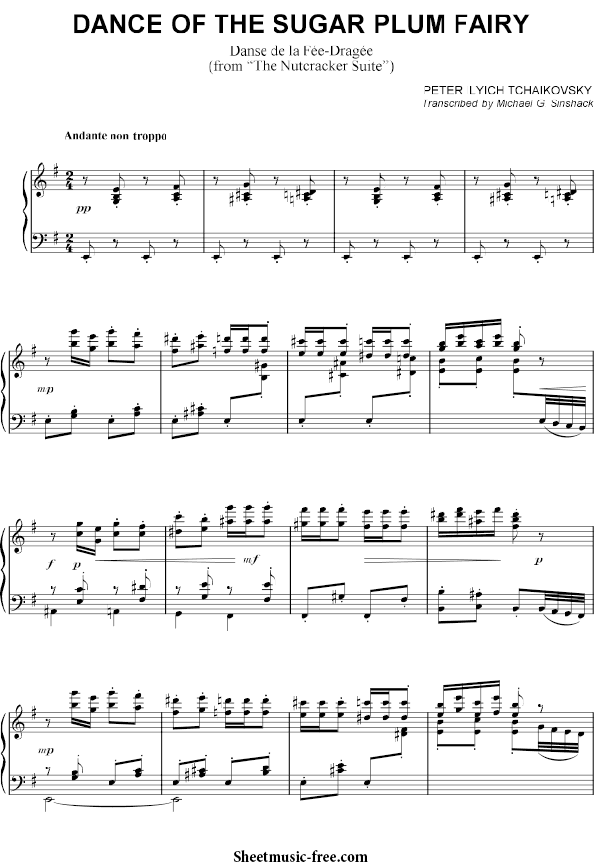Dance of the Sugar Plum Fairy Sheet Music PDF Tchaikovsky Free Download
“Dance of the Sugar Plum Fairy Sheet Music PDF Tchaikovsky” for Piano Sheet Music, Scoring Piano Solo , Original key: E minor, number of pages sheet music PDF: 3, and Lyrics song Dance of the Sugar Plum Fairy Sheet Music PDF Tchaikovsky Free Download.

| INFO SONG | |
|---|---|
| Title: | Dance of the Sugar Plum Fairy |
| Artist: | Tchaikovsky |
| Instrument: | Piano Sheet Music |
| Key: | E minor |
| Metronome: | 92 |
| Scoring: | Piano Solo |
| Styles: | Classical, Movie, TV, Soundtrack |
| Difficulty: | Difficult |
| File type: | |
| Pages: | 3 |
| Download: | Free |
Dance of the Sugar Plum Fairy Sheet Music Tchaikovsky Download
Free Download Dance of the Sugar Plum Fairy Tchaikovsky. Contains printable Sheet Music PDF format.
Click Read more to download Sheet Music PDF.
Video
Info Dance of the Sugar Plum Fairy Tchaikovsky
Dance of the Sugar Plum Fairy
(INSTRUMENTAL)“Dance of the Sugar Plum Fairy’” is a dance for a ballerina. It is the third movement in The Nutcracker pas de deux. Tchaikovsky.
Tchaikovsky introduced the celesta to Russian music lovers on 19 March 1892 when the Nutcracker Suite was performed for the Russian Musical Society in St. Petersburg. The instrument is forever identified with the Sugar Plum Fairy. It is heard in other parts of Act 2 of The Nutcracker besides the Sugar Plum Fairy’s dance. The “Dance of the Sugar Plum Fairy” is one of the ballet’s best known musical numbers. It is often “jazzed up” for television commercials at Christmas time.
Petipa gave Tchaikovsky extremely detailed instructions for the composition of each number, down to the tempo and number of bars. The completion of the work was interrupted for a short time when Tchaikovsky visited the United States for twenty-five days to conduct concerts for the opening of Carnegie Hall. Tchaikovsky composed parts of The Nutcracker in Rouen, France.
Choreographer Marius Petipa wanted the Sugar Plum Fairy’s music to sound like “drops of water shooting from a fountain”. Tchaikovsky found the ideal instrument to do this job in Paris in 1891. It was then that he came across the recently invented celesta. This instrument looked like a piano. It sounded like bells. Tchaikovsky wrote, “[The celesta is] midway between a tiny piano and a Glockenspiel, with a divinely wonderful sound.” He wanted to use the celesta in The Nutcracker. He asked his publisher to buy one. He wanted to keep the purchase a secret. He did not want other Russian composers to “get wind of it and … use it for unusual effects before me.”
Tchaikovsky introduced the celesta to Russian music lovers on 19 March 1892 when the Nutcracker Suite was performed for the Russian Musical Society in St. Petersburg. The instrument is forever identified with the Sugar Plum Fairy. It is heard in other parts of Act 2 of The Nutcracker besides the Sugar Plum Fairy’s dance. The “Dance of the Sugar Plum Fairy” is one of the ballet’s best known musical numbers. It is often “jazzed up” for television commercials at Christmas time.
There is little information about the Sugar Plum Fairy’s original choreography. In the first performances the presto at the end of the dance was cut. According to Roland John Wiley, the dance appears to have consisted of short pointe steps, petite batteries, and attitudes in various combinations. He describes the dance as having “a sense of dynamic build up: from delicate angularity … to circular shapes, to plainer but more virtuoso movements—pirouettes to rounds de jambe—near the end.”
The first Sugar Plum Fairy was Antonietta Dell’Era. She was a good technician, but Tchaikovsky’s brother Modest described her as pudgy and unattractive. Although the Sugar Plum Fairy is the prima ballerina of The Nutcracker, she has very little dancing to do. This was a considered a major defect among early critics. Dell’Era tried to expand the role of the Sugar Plum Fairy in later performances by putting a gavotte by Czibulka into the score.Source Wikipedia.
Tchaikovsky Sheet Music
Follow us: Pinterest
More Tchaikovsky Sheet Music
| Title | Artist |
|---|---|
| Dance of the Sugar Plum Fairy Sheet Music Tchaikovsky | Tchaikovsky |

